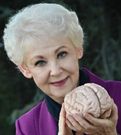Emotional Eating and Weight Management
©Arlene R. Taylor PhD www.arlenetaylor.org
Eat when your body is physiologically hungry and needs food
 “How do you feel today?” asked Marilee.
“How do you feel today?” asked Marilee.
“Hungry for some chicken,” Joe replied.
“Joe!” said Marilee. “Hungry for some chicken is not a feeling.”
Do you know the difference? Joe didn't. Many people don’t. Because of this they end up eating mostly to self-medicate. That’s right: self-medicate. They use food and drink to help themselves feel better. Mind you, there is nothing wrong with wanting to feel good. The brain likes to feel good and will push you to repeat behaviors that helped you feel better in the past. The key is to learn to make choices that give you positive outcomes and help you feel better without using food or beverages to do that for you.
How is food used for self-medication? Foods that contain large amounts of sugar or simple carbohydrates (such as refined flour) can temporarily increase the level of some chemicals in the brain. Serotonin, for example. Knowing that 90% of serotonin (a neurochemical that helps regulate sleep and moods) is found in your gastrointestinal tract—not in your brain—may help you understand the profound impact food has on your entire system. Beverages can have a similar impact.
Soft drinks containing caffeine and sugar mimic amphetamines and provide a temporary energy boost. A food or drink “high” that shoots up blood sugar levels is followed by a rebound “low,” as blood sugar levels fall. Dramatic fluctuations in blood-sugar levels can damage the brain and immune system, contribute to health problems in the long term, and even accelerate the process of aging.
And diet drinks may be even worse. The sweet taste triggers the release of insulin, a hormone produced and secreted by the pancreas. When you eat, insulin moves glucose from the blood to the body's cells and helps turn food into energy. But there’s no glucose to digest in diet drinks, so the insulin creates a blood sugar low. After drinking a diet beverage, studies have shown that people tend to eat more calories at the next meal. Some of the diet sweeteners are thought to be neurotoxic, as well. Aspertame, for example.
Eating to self-medicate is sometimes referred to as “emotional eating.” Do you live to eat or eat to live? Emotional eating tends to pack on the pounds. Not only that, studies have shown that you likely eat different foods depending on whether you feel happy or sad, content or anxious, up in the clouds or down in the dumps. Emotional eating typically involves gravitating toward comfort foods when you feel down and toward other types of food (sometimes healthier foods and beverages) when you feel up.
You can only manage what you can label and describe: your comfort foods, for instance. Do you know what yours are? What do you gravitate toward when you are blue or upset? Pasta, mashed potatoes and gravy, meatloaf, and snacks such as sweets or chips?
What do you eat when you feel great, when you want to celebrate something with family and friends? Some head for pizza, chicken wings, potato salad and baked beans, or fast-food burgers and fries. Others tend to eat more vegetables and fruit when they’re feeling good, even if they cap it off with pie and ice cream.
Keep a food journal. One of the most helpful strategies ever, it can be key in managing your weight and helping you to identify your eating patterns. Include what and when you eat, and your feelings at the time (e.g., happy, sad, anxious, angry, fearful, bored…).
Learn to recognize when your brain and body need food, as opposed to emotional eating. If you experience what you think are hunger pangs, ask: Do you really need food or are you just in the habit of eating more food than you really need? If you are not physiologically hungry, are emotions and feelings driving your demand to eat?
If it’s been four or five hours since you ate a healthy balanced meal, your body may actually need food. If it’s only been a couple of hours, something else may be triggering what initially appear to be hunger pangs.
- You may be thirsty rather than hungry. Drink a glass of water, the beverage “of the gods.” Wait fifteen minutes and see if that satisfies your brain and body. It’s easy to misidentify dehydration as hunger. If you drink enough water to have two very pale urines a day (unless you have a medical condition that requires limitation of fluids), you will likely avoid dehydration.
- Perhaps you’re bored or have developed the habit of grazing all day. Distract yourself. Read something interesting, take a short walk, do your favorite hobby, or work some brain aerobic exercises to age-proof your mind. Anxious about something? Identify the issue and take steps to resolve it.
If you choose to eat a snack, make it a healthy one. For example:
- An apple with a few (a few!) raw nuts
- A couple sticks of celery with a little (a little!) peanut butter
- A slice of avocado on a few baked whole grain crackers
- A little hummus with some raw veggies (celery, carrots, broccoli)
Bottom line: Learn the difference between genuine hunger pangs and triggers related to old habit patterns or to emotions and feelings. Eat when you are physiologically hungry. Eat to live rather than living to eat. Avoid dramatic fluctuations in blood sugar levels. When you do decide to eat, select healthy foods and beverages. Then sit down, eat slowly, and enjoy what you eat. Being hungry and then eating nutritious food in pleasant surrounding makes for good company and a happy brain and body.

